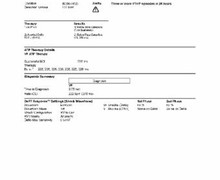Lead fracture and multiple charges of the capacitors
Tracing
Manufacturer Boston Scientific
Device ICD
N° 4
Patient
This 73-year-old man underwent implantation of a Boston Science dual chamber defibrillator 8 years earlier, for secondary prevention of sustained VT in the context of ischemic cardiomyopathy. He underwent replacement of the pulse generator and implantation of a Teligen defibrillator. Multiples episodes of VT and non-sustained VF, requiring 1 or 2 sequences of ATP, were observed during a routine ambulatory visit.

Graph and trace
Tracing
- AP-Sr VP-Sr cycle, where Sr means sensor; therefore, the rate was set by the sensor: sensor-responsive mode;
- oversensing of signals of variable amplitudes and morphologies by the ventricular channel in the VT or VF zones; the high-voltage channel was free from oversensing, allowing the differentiation of the spontaneous ventricular events; the atria were paced at the sensor-driven rate; the atrial rate was variable as it was influenced by ventricular oversensing;
- VF counter fulfilled (V-Epsd);
- intermittent oversensing; at the end of Duration, the rhythm was diagnosed as sinus; no therapy was delivered;
- further ventricular oversensing;
- the VF counter was fulfilled and, at the end of Duration, the first therapy was delivered;
- during ATP (Quick Convert), ventricular capture was intermittent (2 effective and 6 ineffective stimuli);
- oversensing continued after ATP and the charge of the capacitors begins (the first cycle after the ATP sequence was not counted; thereafter, 2 out of 3 cycles were classified in the VT or VF zone, explaining the onset of the capacitors charge);
- at the end of oversensing, the charge was aborted (the 6 out of 10 short cycles criterion was no longer fulfilled);
- oversensing resumed;
- the VT counter was fulfilled (V-Detect);
- a sequence of ATP was delivered; the ventricular stimuli failed to capture.
Graph
The graph suggests a lead dysfunction with presence of a cloud of ventricular events inconsistent with a ventricular arrhythmia.
Other articles that may be of interest to you







The association of an abnormal impedance and a tracing showing intermittently short and disorganized cycles of variable amplitude, was highly suggestive of lead dysfunction. The graph also showed a characteristic aspect of a cloud of points with very short cycles at the limit of the ventricular blanking period. In this asymptomatic patient, remote monitoring would have enabled an early diagnosis, which could have prevented the delivery of inappropriate therapies. Likewise, an early diagnosis would have prevented a succession of inappropriate charges, which, even when aborted, consume energy and can markedly shorten the lifespan of the device.